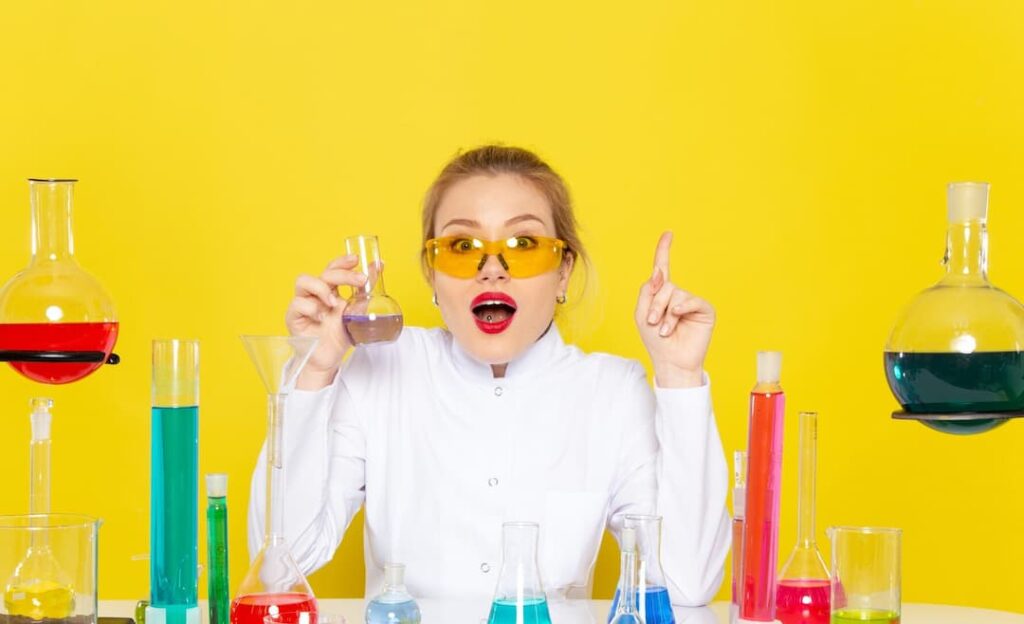I’m here to share some thoughts on Chemistry IA Topic Ideas for IB Coursework. When I started working on my project, I was totally surprised by the sheer variety of chemistry ia ideas and chemistry ia topics available. I spent hours checking out different sources and scribbling down notes on potential projects, and I soon found myself caught between a bunch of ib chemistry ia ideas that sounded really interesting and some chemistry ia questions that made me pause and really think about what I wanted to explore.
It wasn’t just about picking a topic—it was about finding one that clicked with my interests and the experiments I could actually pull off in the lab. I remember discovering some easy chemistry ia ideas that were super straightforward to start with, while other options pushed me to get more creative with my methods.
I even looked at several ib chemistry ia examples that showed how students linked their theory with hands-on experiments, which helped me figure out how to connect my own ideas with solid evidence.
I mixed up some solid ia ideas chemistry with a few ib chemistry ia topics that challenged me to set up experiments with measurable outcomes. Even some hl chemistry ia ideas popped up on my radar, offering a bit more complexity that really added an extra layer to my project.
Chemistry IA Topics
Overall, sifting through all these choices taught me that the best part is experimenting with different approaches until you find what fits your style and the resources you have available.
Every topic includes three research questions along with a brief overview of how students can approach the investigation, design experiments, and analyze data in line with IB Chemistry IA criteria.
1. Reaction Rates and Temperature
- RQ1: How does temperature affect the rate of the iodine clock reaction?
Overview: Students can perform the iodine clock reaction at different temperatures, record the time taken for the color change, and plot reaction rate versus temperature to determine the activation energy using the Arrhenius equation. - RQ2: To what extent does increasing temperature influence the rate of decomposition of hydrogen peroxide catalyzed by manganese dioxide?
Overview: Measure the oxygen evolution or volume produced at various temperatures and analyze the relationship between temperature and reaction rate. - RQ3: How does temperature variation affect the rate constant of the reaction between sodium thiosulfate and hydrochloric acid?
Overview: Monitor the time required for the appearance of turbidity at different temperatures, then calculate rate constants and discuss the temperature dependence using kinetic theory.
2. Concentration Effects on Reaction Kinetics
- RQ1: How does varying the concentration of sodium thiosulfate affect the rate of the iodine clock reaction?
Overview: Change the sodium thiosulfate concentration while keeping other variables constant and measure the time to reaction completion, plotting concentration versus rate. - RQ2: To what extent does the concentration of hydrochloric acid influence the reaction rate in the thiosulfate-clock experiment?
Overview: Vary acid concentration, record reaction times, and analyze the data to determine the order of reaction with respect to HCl. - RQ3: How does altering the concentration of reactants affect the overall rate constant in a redox reaction?
Overview: Perform controlled experiments with different concentrations, determine reaction rates, and compare rate constants to elucidate reaction order.
3. Catalysis and Reaction Mechanisms
- RQ1: How does the presence of a catalyst affect the rate of decomposition of hydrogen peroxide?
Overview: Compare reaction rates with and without a catalyst (e.g., potassium iodide) and analyze how catalysts lower activation energy. - RQ2: To what extent does the concentration of a catalyst influence the rate of a given reaction?
Overview: Vary catalyst concentration systematically in the decomposition of H₂O₂ and measure reaction times to determine the catalyst’s efficiency. - RQ3: How do enzyme catalysts compare to inorganic catalysts in terms of reaction rate enhancement in similar conditions?
Overview: Compare the rate of reaction using an enzyme (e.g., catalase) versus an inorganic catalyst, discussing differences in catalytic mechanisms and efficiency.
4. Equilibrium and Le Chatelier’s Principle
- RQ1: How does changing the concentration of reactants affect the position of equilibrium in the esterification reaction between acetic acid and ethanol?
Overview: Conduct experiments with varied initial concentrations, measure ester yields, and analyze shifts in equilibrium position. - RQ2: To what extent does temperature affect the equilibrium constant of a reversible reaction?
Overview: Measure equilibrium concentrations at different temperatures for a chosen reversible reaction and determine changes in the equilibrium constant. - RQ3: How does the addition of a common ion influence the equilibrium of a solubility reaction?
Overview: Investigate the solubility of a sparingly soluble salt in the presence of a common ion, and relate findings to Le Chatelier’s principle.
5. Acid-Base Titration and pH Analysis
- RQ1: How does the strength of an acid affect its titration curve when titrated with a strong base?
Overview: Compare titration curves of strong versus weak acids using pH indicators or a pH meter, and discuss buffering capacity and equivalence points. - RQ2: To what extent do different indicators affect the accuracy of endpoint detection in titration experiments?
Overview: Perform titrations using various indicators, compare endpoint determination with pH meter readings, and assess precision. - RQ3: How does the dilution of an acid affect its titration curve and equivalence point volume?
Overview: Titrate acids at varying dilutions and compare the resulting curves, analyzing the impact on titration accuracy and sensitivity.
6. Solubility and Temperature Effects
- RQ1: How does temperature affect the solubility of potassium nitrate in water?
Overview: Determine solubility at different temperatures by measuring the maximum concentration that remains in solution, then plot a solubility curve. - RQ2: To what extent do impurities affect the solubility of a sparingly soluble salt?
Overview: Introduce known impurities into the solution, measure solubility changes, and discuss the effects on crystal formation. - RQ3: How do pressure changes influence the solubility of a gas in a liquid?
Overview: Investigate the solubility of carbon dioxide in water under varying pressures and analyze the data using Henry’s law.
7. Electrochemistry and Redox Reactions
- RQ1: How does the concentration of electrolytes affect the cell potential in a galvanic cell?
Overview: Construct galvanic cells with different electrolyte concentrations, measure potentials, and relate findings to the Nernst equation. - RQ2: To what extent does temperature influence the voltage output of a galvanic cell?
Overview: Vary the temperature of a galvanic cell system and record voltage changes, discussing the thermodynamic implications. - RQ3: How do different electrode materials affect the efficiency and potential of an electrochemical cell?
Overview: Compare cells constructed with various electrodes, measure their potentials and current outputs, and discuss material properties.
8. Reaction Mechanisms and Intermediate Formation
- RQ1: How does the concentration of reactants influence the formation of intermediates in a multi-step reaction?
Overview: Use spectrophotometry to monitor intermediate species in a known multi-step reaction and analyze concentration dependencies. - RQ2: To what extent can reaction intermediates be detected using UV-Vis spectroscopy?
Overview: Design experiments to capture transient intermediates and assess their absorption spectra, discussing limitations of detection methods. - RQ3: How do changes in reaction conditions (temperature, solvent polarity) affect the formation of intermediates?
Overview: Vary conditions in a model reaction, monitor intermediate formation, and propose mechanistic pathways based on the data.
9. Kinetics of Complex Formation
- RQ1: How does ligand concentration affect the rate of formation of a coordination complex?
Overview: Monitor the formation of a colored complex via spectrophotometry at different ligand concentrations, plotting absorbance against time. - RQ2: To what extent does temperature influence the rate constant for the formation of a metal–ligand complex?
Overview: Perform the complexation reaction at various temperatures, calculate rate constants, and discuss the activation energy using the Arrhenius equation. - RQ3: How do solvent properties affect the kinetics of complex formation?
Overview: Compare the reaction rate in solvents with different polarities and dielectric constants, analyzing solvent effects on reaction mechanisms.
10. The Chemistry of Corrosion
- RQ1: How does the concentration of chloride ions affect the rate of corrosion in iron?
Overview: Expose iron samples to solutions with varying chloride concentrations, measure mass loss or corrosion products, and analyze corrosion rates. - RQ2: To what extent do different inhibitors reduce the corrosion rate of metals in acidic environments?
Overview: Test various corrosion inhibitors, measure changes in corrosion rates through weight loss or electrochemical techniques, and compare their efficiencies. - RQ3: How does temperature influence the rate of corrosion in metallic samples?
Overview: Perform corrosion experiments at different temperatures, record reaction rates, and discuss the kinetic parameters influencing corrosion processes.
11. Synthesis and Characterization of Coordination Compounds
- RQ1: How does variation in ligand concentration affect the yield of a synthesized coordination complex?
Overview: Synthesize the complex under different ligand concentrations, purify the product, and determine yield using gravimetric analysis. - RQ2: To what extent does changing the pH of the reaction medium influence the structure of the resulting complex?
Overview: Conduct the synthesis at various pH values, characterize products using spectroscopy and crystallography, and analyze structural differences. - RQ3: How do reaction time and temperature affect the purity and yield of a coordination compound?
Overview: Vary reaction conditions systematically, then use techniques such as IR spectroscopy and melting point analysis to evaluate product purity.
12. Analysis of Food Chemistry: Vitamin C Degradation
- RQ1: How does storage temperature affect the rate of vitamin C degradation in fruit juices?
Overview: Measure vitamin C content over time at different temperatures using titration or spectrophotometric methods, and plot degradation curves. - RQ2: To what extent does light exposure accelerate the degradation of vitamin C in commercially bottled juices?
Overview: Compare vitamin C levels in samples stored under light versus dark conditions, discussing the role of photo-oxidation. - RQ3: How does pH variation in fruit juice affect the stability of vitamin C during storage?
Overview: Adjust the pH of fruit juice samples, measure vitamin C concentration over time, and analyze how acidity or alkalinity influences degradation rates.
13. Investigating Polymerization Reactions
- RQ1: How does the concentration of initiator affect the rate of polymerization of methyl methacrylate?
Overview: Monitor the polymerization process using viscosity measurements or calorimetry, and relate initiator concentration to reaction kinetics. - RQ2: To what extent does temperature influence the molecular weight distribution of a synthesized polymer?
Overview: Synthesize polymers at different temperatures, then use techniques such as gel permeation chromatography (GPC) to analyze molecular weight distributions. - RQ3: How do reaction time and monomer concentration affect the yield and properties of a polymer?
Overview: Vary reaction parameters systematically, measure polymer yield, and characterize properties (e.g., tensile strength) to discuss structure–property relationships.
14. Environmental Chemistry: Analysis of Water Hardness
- RQ1: How does the concentration of calcium and magnesium ions vary in local water sources?
Overview: Collect water samples from different locations, perform titrations using EDTA, and analyze variations in hardness. - RQ2: To what extent do water treatment methods (e.g., ion exchange) reduce water hardness?
Overview: Compare hardness measurements before and after treatment, discussing the efficiency of common water softening techniques. - RQ3: How does seasonal variation affect the hardness of surface water in a given region?
Overview: Collect samples over several months, measure ion concentrations, and analyze trends in relation to seasonal changes.
15. Investigating Reaction Yield and Purity in Organic Synthesis
- RQ1: How do variations in reaction conditions (temperature, solvent) affect the yield of an esterification reaction?
Overview: Optimize conditions for the synthesis of an ester, measure yields via isolation and purification, and compare efficiencies under different setups. - RQ2: To what extent does the purity of reagents influence the final product purity in an SN1 reaction?
Overview: Conduct reactions using reagents of varying purities, then use techniques like thin-layer chromatography (TLC) to assess product purity. - RQ3: How do reaction time and catalyst concentration affect the yield of a nucleophilic substitution reaction?
Overview: Systematically vary reaction parameters, measure product yield, and analyze kinetic data to determine optimal conditions.
16. The Chemistry of Food Preservation: Antioxidants
- RQ1: How does the addition of natural antioxidants (e.g., vitamin E) affect the rate of lipid oxidation in edible oils?
Overview: Monitor oxidation levels (using peroxide value or TBARS assay) over time in oils with and without added antioxidants. - RQ2: To what extent do synthetic antioxidants compare with natural ones in delaying rancidity in fats?
Overview: Compare oxidative stability in samples treated with synthetic versus natural antioxidants under controlled storage conditions. - RQ3: How do different concentrations of antioxidants influence the shelf-life of a food product?
Overview: Prepare samples with varying antioxidant levels, track quality parameters over time, and determine the optimal concentration for preservation.
17. Investigating Redox Titration Techniques
- RQ1: How does the concentration of a reducing agent affect the titration curve in an iodine-thiosulfate titration?
Overview: Perform titrations at different reducing agent concentrations, record volume data, and analyze titration curves to determine equivalence points. - RQ2: To what extent does temperature affect the endpoint detection in redox titrations?
Overview: Conduct titrations at varied temperatures, compare indicator responses, and discuss any shifts in endpoint determination. - RQ3: How do different redox indicators compare in their effectiveness for endpoint detection in titrations?
Overview: Use multiple indicators for the same titration, compare precision and accuracy, and discuss the advantages and limitations of each.
18. The Impact of pH on Reaction Mechanisms in Organic Chemistry
- RQ1: How does altering the pH of the reaction medium influence the rate of hydrolysis of an ester?
Overview: Vary pH systematically during an ester hydrolysis reaction, measure product formation over time, and analyze reaction kinetics. - RQ2: To what extent does pH affect the mechanism of a nucleophilic substitution reaction in aqueous solution?
Overview: Conduct reactions at different pH levels, compare reaction rates and product distributions, and discuss mechanistic pathways. - RQ3: How do acidic and basic conditions influence the yield of an aldol condensation reaction?
Overview: Perform the reaction under different pH conditions, measure product yields, and analyze how pH shifts reaction equilibrium and kinetics.
19. Analysis of Chemical Equilibria Using Spectrophotometry
- RQ1: How does changing the concentration of reactants shift the equilibrium position in a colored complex formation reaction?
Overview: Use spectrophotometric methods to measure absorbance changes at equilibrium as reactant concentrations vary, then plot data to determine equilibrium constants. - RQ2: To what extent does temperature influence the equilibrium constant of a reversible reaction monitored by UV-Vis spectroscopy?
Overview: Record absorbance data at different temperatures for a reversible reaction, calculate equilibrium constants, and discuss thermodynamic implications. - RQ3: How does the addition of a common ion affect the absorbance of a solution in a complex ion equilibrium?
Overview: Introduce a common ion, measure absorbance changes, and analyze the results in terms of Le Chatelier’s principle.
20. Green Chemistry: Synthesis and Characterization of Biodegradable Polymers
- RQ1: How does the choice of monomer ratio affect the properties (e.g., tensile strength, degradation rate) of a biodegradable polymer?
Overview: Synthesize polymers with varying monomer ratios, perform mechanical and degradation tests, and correlate composition with material properties. - RQ2: To what extent do reaction conditions (temperature, catalyst type) influence the yield and molecular weight of a synthesized biodegradable polymer?
Overview: Vary reaction parameters systematically, measure product yield and molecular weight distribution (using GPC), and analyze optimal synthesis conditions. - RQ3: How do different biodegradable polymers compare in terms of their environmental degradation rates under simulated conditions?
Overview: Prepare samples of various biodegradable polymers, subject them to controlled environmental tests (e.g., soil burial, composting), and compare degradation profiles.
Wrapping Up
Y’all should select a method or protocol appropriate for their chosen topic, ensuring that they adhere to ethical and safety guidelines while aligning their investigation with the IB Chemistry criteria for a thorough and insightful research project.
I just want to say that working on your Chemistry IA doesn’t have to be a drag. For me, comparing a bunch of chemistry ia topics with a few cool chemistry ia questions made the whole process way more manageable and even fun. I found that mixing various ia ideas chemistry, whether they were the simple, easy chemistry ia ideas or the more challenging ib chemistry ia topics, really helped me pin down a project that felt both doable and exciting.
Checking out those ib chemistry ia examples and specific chemistry ia research questions made it clear that there’s no one right way to set up your investigation—it’s all about finding what gels with your interests and available lab resources. If you’re feeling overwhelmed by the options, just start by experimenting with a few different angles and see which one resonates most with you.
Believe me or not, but once you start comparing and mixing these ideas, your project will take shape in a way that feels totally unique to you.









